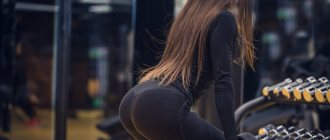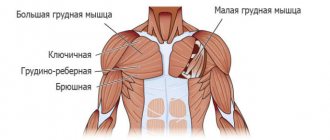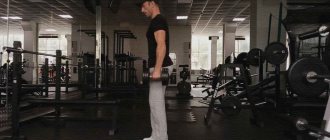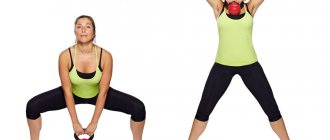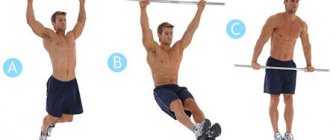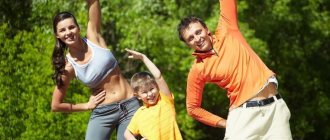To pump up your thighs means to make your legs beautiful and strong. This can be done in different ways. Although pumping up your thighs using proven sets of exercises is much safer and more reliable.
The thigh muscles are one of the large muscle groups located on the lower limbs of a person. Among them there are three subgroups:
- anterior, represented mainly by extensor muscles;
- medial, consisting of the adductor muscles of the thigh;
- posterior ones, which are flexor muscles.
Among the anterior muscles:
- the sartorius muscle, which is the longest muscle on the human body:
- looks like a long narrow ribbon;
- starts from the iliac spine (its top) and ends at the knee, having a complex attachment;
- with its help, the lower leg and thigh bend, at the same time it allows the lower leg to rotate inward, and the thigh outward; the latter is expressed in the muscle providing a position with legs crossed;
- quadriceps:
- occupies the lateral anterior femoral plane and is the largest in the muscle group;
- the lower part of the muscle is located entirely on the lateral surface of the thigh;
- the muscle consists of four heads, the contraction of which leads to extension of the lower leg;
- rectus muscle and three broad muscles (lateral, medial, intermediate):
- have fused heads and a common tendon for all; the latter is attached to the kneecap - on the sides and to the top;
- articular muscle located in front of the thigh under the vastus intermedius muscle:
- it looks like a thin plate;
- the beginning of the muscle is in front of the bone, approximately at the top of its lower third;
- places where the muscles are attached - the lateral and anterior planes, which belong to the bursa of the knee joint.
The medial muscles of the thigh are represented by:
- pectineus muscle, whose task is to flex and adduct the thigh, to ensure its outward rotational movement:
- appears to be a quadrangular plate;
- the beginning of the muscle is the pubis, its crest and the superior branch;
- thin muscle that provides hip adduction:
- in addition, it helps to bend the lower leg, ensuring that the leg rotates inward;
- the muscle is located under the skin;
- the beginning of the muscle is the pubis, its lower branch;
- muscle attachment - on the tibia, in its tuberous part;
- short, long, adductor magnus muscles:
- the large muscle is the most powerful of the three; it adducts the thigh, it helps other muscles rotate the thigh outward; its beginning is the ischial tubercle, pubic bones (lower branch, branch extending from the ischium);
- the short and long muscles adduct and rotate the thigh outward; the short muscle looks like a triangle, starts from the pubis (lower branch); the appearance of the longus muscle is an irregular triangle, its location is the femoral anteromedial plane.
Among the hamstring muscles:
- biceps muscle: it extends the thigh, flexes the lower leg; with the hip bent, rotates the lower leg outward;
- semitendinosus muscle: extends the thigh, flexes the lower leg; when the hip is flexed, it helps to internally rotate the lower leg; helps to straighten the body;
- membranous muscle: its task is to flex and rotate the lower leg, extend the thigh.
Thigh stretch
1.To stretch the muscles of the back surface, you need to sit on the ground - your back is straight; the legs are extended, pressed to the ground and connected by the feet.
The exercise involves bending toward your feet while keeping your back straight and your knees not bent. The bends are done deeply, while pulling the toes towards you, which helps to increase muscle stretching.
Exercise option: legs are pressed to the ground, but separated from each other by 90°. Bends are performed alternately to each foot, twisting the torso a little. The back and legs remain straight.
2. To stretch the quadriceps muscles, stand on one leg, bend the other at the knee and grab the foot in the bony part. Pull your leg up as much as possible.
Features of the exercise: support, for example, with your second hand on a wall, helps you maintain balance; with the left hand they grab the foot of the same leg and vice versa.
3. The internal muscles are stretched from a position lying on your back next to a wall. In this case, the buttocks rest against the wall, the legs are extended upward and pressed against the wall.
The exercise consists of symmetrically lowering your legs to the sides - ideally towards a cross split.
Features: legs are constantly pressed along the entire length to the wall.
Second exercise: sit on the floor, bend your knees so that the soles of your feet are connected. They clasp the feet with the palms, the elbows are launched between the legs and pressed to the thighs (to the inner surface).
The essence of the exercise: bend forward, pressing on the thighs with the forearms of the hands.
Tips for implementation
Here are some useful recommendations that will help you get the maximum benefit from special training for your hips and legs:
- Muscle efforts should be made while exhaling and relaxing while inhaling.
- In the context of regularity of classes, the ideal option is two to three times a week.
- The training process should always end with stretching. By doing so, you will increase the elasticity of the quadriceps and minimize the pain associated with strength training and the period after it.
Sets and reps
For maximum efficiency, I recommend aiming for 15-20 repetitions in one approach. After a short rest of up to half a minute, the approaches are repeated (about 3 approaches in total).
If at the initial stages such a number of approaches seems overwhelming to you, you should not torture yourself - it is better to do as many as you can. I recommend adding one or two repetitions to each subsequent session.
Warm-up and stretching
You should never start exercising without first warming up your muscles. I recommend performing aerobic exercises at a moderate pace for 5-10 minutes.
Stretching or stretching will make the muscle more flexible and resilient. I strongly recommend doing the following types of stretches after working out your quadriceps:
- Bend forward while sitting on the floor.
- "Frog".
- Kneeling stand.
Weights
For girls and women striving for an ideal figure, it is better to select sets of moderate difficulty and it is advisable not to use weights, so as not to overwork the area being worked. For men who want to work out their quadriceps well, I recommend starting with moderate weights, gradually increasing them to maximum and always starting with a warm-up (for example, with a barbell or light weight, 20-25 kg).
Warm-up for thigh muscles
1.Bending the body
Stand straight, legs straight, feet spread apart shoulder-width apart.
Tilt the body (without bending the knees) first towards the left, then towards the right leg. Straighten the body.
Place your feet together, bend towards your knees as close as possible and stay in this position for 3…5 seconds.
The exercise is repeated 30...40 rubles.
2.Tilting-twisting
The starting position is the same as in the previous exercise.
Extend your arms vertically upward. They look at them and bend over as completely as possible 15 times, first to one leg, then to the other.
Features: arms and torso remain on the same straight line when bending.
3.Hip Rotation
From a standing position, with legs extended and feet spread apart (shoulder-width apart), hands are placed on the berms.
Make circular movements with your hips while maintaining the same position of your feet and head.
Features: the legs do not bend when the hips rotate at the knees.
4.Warming up the knees
Connect your legs and bend them easily at the knees. The palms of the hands are placed on the knees.
Exercise – rotation of the knees with maximum amplitude. Performed for a period of time – at least 2 minutes.
Strength loads on the quadriceps and other muscles of the upper legs
The large and strong femoral muscle is the quadriceps, the name is due to the fact that the muscle consists of four main bundles - direct, intermediate, external and internal. The muscles are attached to the kneecap and shin bone. Pumping up the quadriceps is necessary for normal maintenance of the knee joint.
Exercises for the quadriceps muscle are energy-intensive and complex, for this reason the maximum number of executions is 3 sets of 10 times.
| Exercise | How to perform | What works |
| Squats with additional weight (barbell, dumbbells) are an effective classic exercise that engages the quadriceps. | The barbell is installed at shoulder level, stand under the bar and lower the barbell onto your shoulders, it should be on your upper back. We hold the barbell with our hands on both sides and find the most stable position; as we exhale, we begin to sit down, with our feet shoulder-width apart and our knees not extending beyond our feet. As you inhale, we rise to the starting position. Repeat 15-20 times. You can do this at home with bottles filled with water. Attention! Your back should be straight throughout the entire exercise. | Quadriceps femoris, biceps, adductors, gluteal muscles. |
| Lunges with alternating legs (additional load in the form of dumbbells) are aimed at activating the muscle fibers on each leg alternately. | The arms are lowered along the body, with a dumbbell in each hand; their weight depends on the gender and fitness of the individual. Basic stance – feet shoulder-width apart, step forward with your right foot. The leg remaining behind rests on the toe. The main weight of the body falls on the front leg, hold the position for 3 seconds and return to the starting position. We change the leg. | Quadriceps, hamstrings, adductors. |
| Side sliding lunges are a variation of side lunges that stretch the hip muscles. The gluteal muscles and quadriceps major are involved. | Feet shoulder-width apart, arms extended in front of the chest. The movement to the side begins smoothly; while exhaling, we slide our foot without lifting it off the floor. The body moves a little forward, bending too much is prohibited! The leg moves away to a distance that is accessible to the person thanks to stretching. The supporting leg should form 90 degrees. The knee does not go beyond the toe. After squatting, we pull the leg back while inhaling; this movement is done while tensing the thigh muscles. The approach is performed with one leg completely 15 times, after which there is a change. | Quadriceps, gluteus maximus and medius, hamstrings. |
To avoid back injuries, it is recommended to use a special belt; it will secure the muscles of the spinal region.
Inflating the inside of the house
This surface of the thigh is capricious in terms of pumping, and therefore requires special treatment. It is easier to pump up your inner thighs in the gym. Although there are a number of exercises that can achieve quick results at home.
1.V-shaped stretch
Sit on the floor, straighten your legs and spread them as far apart as possible (form the letter “V” in plan). Straighten your back, tense your abdominal muscles and bend forward as much as possible. At the moment of greatest tension, they linger in the achieved position for 10...15 seconds, after which they return back.
Note: When stretching, do not go beyond pain or into the discomfort zone.
2.Butterfly stretch
Sitting on the floor, bend your knees, connecting the soles of your feet. Knees are spread apart, palms are placed on them.
Exercise: Gently press your palms onto your knees, pressing them to the floor. Ideally, your feet will be completely pressed against the floor surface. In the extreme position, they linger for 10...15 seconds, then release the pressure.
Note: If you feel pain, you should stop immediately.
3.Frog stretch
Having dropped to the floor, they lean back. The legs are bent at the knees and connected to each other by the soles of the feet.
You can also pump up your inner thighs with this exercise: relax your knees and pull your feet towards the groin. Having reached the extreme position possible for you, linger in it, take 10 full exhalations and inhalations and return your knees back.
4.Hip stretch
Stand up straight, take one leg back, transfer your body weight to the other and bend it at the knee. Tighten your buttocks and try to lower your body as much as possible. The exercise will be more difficult if you keep both arms raised up.
Having reached the possible limit in lowering the body, they linger in it for three full exhalations and inhalations. Then they repeat everything, but changing the leg.
5. Squats
By performing this exercise, you can, in addition to the inner surface, pump up the quadriceps of the thighs and buttocks.
Stand up straight, legs spread wide. The feet are positioned 45° outward. Relax your shoulders, keep your back relaxed.
Exercise: stretch your arms forward in front of you. Slowly lower yourself into a squat until you feel a stretch in the muscles (the axes of your thighs become parallel to the floor). Squeeze the buttocks and return back.
The exercise will become more difficult if you use dumbbells.
6. Leg lunges
In addition to the thighs, the exercise serves to pump up the abdomen and buttocks.
Take a standing position straight, straighten your back and press your legs tightly against one another.
Exercise: take a big step forward with one leg and bend the knee to a position at which a right angle is formed in it. At the same time, the knee of the other leg touches the floor.
They linger for 1…3 seconds and come back. Repeat all 10...14 rows, then change legs.
7.Hip swing
Stand directly behind the chair at a distance of 40...50 cm, grab the back and lean slightly forward. Shift your balance to your right leg, placing your left leg slightly forward.
Exercise: tense your stomach and perform side-to-side movements with your left leg (like a pendulum). Repeat 12…15 times, then change legs.
8. Squeezing your knees
They sit on the edge of a chair. The back is straight, legs are bent - feet on the floor. Take the ball and press it between your knees. They do this with maximum muscle tension, holding in the extreme position for 10 seconds.
Then slowly release the pressure until you can hold the ball. Number of repetitions 8...12, sets 2...3.
Leg raises
They lie on their left side, bend their right leg and throw it forward over the left - the foot is placed on the floor in front of the knee. The left arm is bent and placed under the head. With your right hand, rest on a comfortable place on the floor.
Exercise: strain the muscles of the left leg and lift it 10...15 cm up. They pause and lower, but do not allow contact with the floor. Reps 15...18. Then they change position and do everything with their right foot.
10.Scissors
Lay on your back, legs extended, back pressed to the mat. Place your hands along your body and relax it. The legs are raised to an angle of approximately 45°, spread as far apart as possible. Then they bring them together, lead them one after the other. Repeat the exercise 20 rubles. with 2…3 approaches.
Features: change the position of the legs (one above the other) when crossing.
Example workout
At home
Warm up (running in place, climbing stairs down/up or jumping rope) – 5-10 minutes.
- Supported squats (with a chair or against a wall) – 3 reps. 10 repetitions.
- Leg raises on the floor - 3 times, 15 repetitions on each leg.
- Stepping onto a support – 3 times, 10 repetitions.
- Bulgarian lunges – 3 reps. 12 lunges on each side.
In the gym
Step warm-up or jogging on the treadmill – 5-10 minutes.
- Breeding raised legs to the sides (on the floor) – 1 rep. 15-20 repetitions.
- Plie squats – 3 times, 10-15 repetitions.
- Side lunges – 3 reps. 12-15 times.
- Squeezing a fit ball with your knees – 2 reps. 20 times.
Pumping up the back of the thigh
Pumped back thighs are needed for an elegant and sculpted silhouette of your legs. Exercises for this are performed with dumbbells, a barbell, a step platform, and leg weights.
1 exercise
Take dumbbells with both hands and hold them down. The body is straight.
With a deep breath, lift the dumbbells up and simultaneously move one of the legs back. I lower my arms down and put my leg back in place. Repeat the exercise, changing legs.
The exercise requires 2...3 approaches and 4...12 repetitions in each of them.
Note: The effectiveness of the exercise will increase if you wear heavy shoes or wear weights on your ankles.
Exercise 2
A barbell is placed next to the step platform. They stand on the platform, bend with their legs straight, grab the barbell and lift it by straightening their torso. Hands with the barbell are lowered. Then I slowly lower the bar to the floor.
Perform 2...3 approaches, repeating the exercise in each for 4...10 rubles.
Exercise 3
Standing position. Take a barbell and place its bar on your shoulders. Take a small step forward with one of your legs, placing your feet in one line.
Exercise: inhale and move the back leg back; At the same time, lower the body down to a position where the bend of the front leg at the knee is 90°. Proper execution of the exercise leads to a feeling of tension in the posterior muscles. Then change the position of the legs.
A little anatomy
The anterior femoral part pumps faster than other muscle groups, and when loaded with weight, it increases in volume and “swells” slightly. The thigh muscles are designed to support the body in an upright position by moving the bone “levers” of the lower extremities.
It is customary to distinguish three groups of femoral muscle plexuses:
- Anterior (mainly extensor muscles).
- Posterior (extensor function).
- Medial (adductor muscle groups).
The main muscle formation of the anterior surface of the thigh is the quadriceps, which is divided into 4 components: lateral and rectus, medial and intermediate.
Pumping up the front thigh
1 exercise
Stand up straight, legs spread slightly, while the spots are turned outward. Retract your lower abdomen and stretch your arms forward.
You can pump up the adductor muscles of the thigh by performing the following exercise: with a straight back, slowly lower the torso down by bending the knees. They also straighten up slowly, but not completely – they immediately begin the next squat.
The exercise is repeated at least 10 times, maximum 20 times.
Features: Hips should not fall below the knees. The exercise is complicated by pumping the legs in the form of a dozen fast and small amplitude (1...1.5 cm) squats and lifts in the position of the largest general squat. After this they freeze for 10 seconds. and return back.
Exercise 2
In order to pump up the broad thigh muscles, you need to take a semi-squat position.
Place your feet together, place your hand on the support and rise onto your toes. Bend your knees a little, pull in your stomach, tighten your buttocks and slowly lower yourself 7…12 cm. Freeze. Then they return back. Do this 10 times.
Exercise 3
Take a comfortable position on your back, bend your legs and press them to your stomach.
Exercise: straighten your legs up, pulling your heels forward. Slowly bring them back. Do the exercise for up to 20 rubles.
Exercise 4
The following exercise will help pump up the lateral thigh muscle: stand next to (40...50 cm) with a wall, with your back to it. Feet together. Lean back to rest your back on the wall.
Exercise: slowly slide your back down the wall until your knees are bent at 90°. Hold for 5 seconds. and return back. 5 repetitions of the exercise are enough.
Exercise 5
Starting position of the previous exercise. But the legs are placed apart and the socks are turned out a little.
Exercise: slide down the wall, leaning your back on it, to a position that corresponds to sitting on a chair. Hold for 5 seconds. and return back. Repeat the exercise 5 times, maximum 10 times.
Note: after strengthening the muscles, the delay is increased to 10 seconds.
Thigh muscles - anatomy and importance for beginners in strength training
The thigh muscles are among the largest muscles in the human body.
The extent to which these muscles are developed significantly determines the strength characteristics of athletes and bodybuilders. This muscle group directly affects the body’s endurance and serves as one of the main indicators of the level of general physical fitness. For beginners in bodybuilding, the first and most pressing question will be: how to gain muscle mass
quickly and efficiently. At the same time, the subtlety of the process lies both in the overall mass gain and in individual muscle groups. In order for your thighs to become unusually strong, resilient and acquire a voluminous, sculpted profile, you will need to systematically perform special exercises to strengthen the thigh muscles.
Physical exercise system
using special weights is the best way to achieve intense muscle growth in the shortest possible time.
When undertaking to do fitness exercises for strength training on the thigh muscles, primary importance will need to be given to the anterior muscle group
.
This includes the quadriceps
, or
quadriceps femoris muscle
, as well as the longest muscle in the human body, called the sartorius. It should be immediately stipulated that the quadriceps will bear the main load during training. And in general, speaking about exercises with the thigh muscles, we mean, first of all, this area directly. So, the quadriceps muscle group consists of four muscle bundles:
● Lateral bundle
- the largest among all the muscles of the thigh, located on its lateral part.
Takes part in every movement that involves the knee joint. ● Medial bundle
– grows in width and is located on the inner side of the thigh, participating in the extension movements of the legs.
Thanks to this muscle, a small bulge is formed at the back of the knee. To pump up the medial bundle, you will need exercises for the inner thigh muscles. ● Intermediate bundle
– located between the medial and lateral bundles, and is also slightly hidden along their edges in the patella region.
Actively promotes squats, running and jumping. ● Straight bundle
– has the longest length among all the quadriceps muscles. It is located in its anterior region, covering other muscles and forming a roundness where it lies. Another difference between a straight beam is that, unlike the others, it has no attachment to the hip bone. In addition to participating in the extension movements of the legs, it is also responsible for their bending.
The main functions of the quadriceps, according to which we will select exercises for developing the thigh muscles, include the following:
● Static
– allows the body to maintain a standing position.
Thanks to the action of the quadriceps, the knee joints withstand the load from the body. ● Dynamic
– allows the knees to move steadily while walking, running and jumping. Using the muscles on the hips, you can perform flexion and extension movements of the legs, pull them towards the knees, and also do pelvic tilts.
A healthy and developed quadriceps allows you to easily climb up (for example, up stairs) and also carry out running movements. Paralysis of this muscle group results in severe difficulty or inability to climb and run.
To the posterior group of thigh muscles
This includes his biceps, as well as the semitendinosus and semimembranosus muscles.
The medial muscle group of the thigh
includes three adductor muscles - large, long and short.
Thus, having examined the anatomical features of the thigh in terms of its muscles, we can come to the conclusion that exercises to strengthen the quadriceps femoris muscle
should be fundamentally basic, because this will allow you to include as many individual muscles and muscle ligaments as possible in the work. But since the quadriceps musculature includes both fast-twitch and slow-twitch fibers, you will also need isolation exercises for the body. By following the further recommendations of the Non-Lazy Sloth, you will definitely achieve not only a strong, but also a proportional and harmonious physique, which many can admire and envy.
Pumping up the lateral thigh
This surface most often accumulates excess fat, leading to the formation of “breeches.” To prevent this from happening, you should pump up the hip abductor muscles, which can be done with the following exercises.
1 exercise
They stand against the wall, stretch out their hands towards it and lean on it. Slowly raise the right leg as far as possible to the side, then lower it. Then everything is done with the left foot.
Features: the leg is lifted with effort; the knees of the legs are slightly bent. The exercise becomes more difficult when lifting a straight, stretched leg.
Exercise 2
You can also pump up the lateral thigh muscles with the following exercise: lie on your left side, bend your knees and pull them towards your stomach until your hips and torso make an angle of 90°. Raise the upper thigh up without opening the feet. Hold for 1…2 seconds. and come back slowly. Repeat the exercise 5...10 times, then turn over and do everything while lying on your right side.
Features: perform the exercise with the muscles as tense as possible.
Exercise 3
Lie on the right side. Leaning on the forearm, lift the pelvis up. Raise the left leg up 20 cm. Hold for 10 seconds, lower. Repeat 2...3 times. Then they turn over, lie on their left side and manipulate their right leg.
Exercise 4
Position – lying on the left side. Extend your left hand forward and place your head on it. With your right hand, rest in front of you on the floor.
Exercise: the right leg is bent at the knee, the left leg is raised straight. The toe is slightly turned down. Then they change position and do everything with the other legs.
Features: movements are performed slowly.
Exercise 5
Starting position as in exercise 4.
Bend the leg lying on top, while pulling the heel back. There should be a 90° angle between the thigh and the calf muscle. Bring your thighs forward a little. Slowly raise the upper thigh up - the leg is parallel or close to it in relation to the floor. Hold the position for 1...2 seconds, lower the hip. They turn over and do everything with the other hip.
A set of stretching exercises
Exercises for the anterior thigh include more than just strength exercises.
Stretching is a very important element of training; it allows muscles to relax after intense exercise, and also helps to improve the process of breaking down fats in tissues.
To effectively stretch, and at the same time not harm your health, you need to adhere to the following rules:
- Classes must be systematic.
- You should be in the stretching position for at least 10 seconds, gradually this figure can be increased to a minute.
- Breathing should be calm and uniform, without delay.
- You cannot stretch the muscles until pain appears. Only a feeling of discomfort in the muscles, but not pain, is acceptable.
Examples of stretching exercises
Standing anterior thigh stretch. Starting position: standing on your left leg, grab your right ankle with your right hand, bent at the knee.
Exercise technique:
- Smoothly pull the heel of the right foot towards the buttocks and count to 10.
- Slowly lower your leg down.
- Perform the exercise with the second leg.
Stretch the front of the thigh in a lunge position. Starting position: standing on your left knee. The right leg, bent at the knee at a right angle, stands on the floor in a forward position, the heel is pressed to the floor. The elbow of your right hand can rest on your right knee.
Exercise technique:
- The body is moved forward, the pelvis is slowly lowered down.
- Then with your left hand you need to grab your left foot and smoothly pull the heel towards the buttock. Keep your back straight and look forward.
- The heel of the right foot and the left knee do not leave the floor.
- Stay in the stretching position for 10 seconds, then smoothly lower your foot to the floor.
- Repeat the exercise with alternating legs.
Stretch the front of the thigh while sitting. Starting position: sitting on a gymnastic mat, bend your knees all the way and spread them apart.
The feet are pulled as close to the pelvis as possible.
Exercise technique:
- They try to touch their knees to the floor.
- In the maximum position they are held for 10 seconds.
Cool down after training thigh muscles
Any workout should always end with exercises that allow your heart rate and stressed muscles to quickly recover. The cool-down itself is quite short and rarely exceeds 10 minutes. This may include:
- exercise on a cardio machine;
- tissue stretching: this accelerates blood flow in the joints, eliminating waste and toxins more intensively, which reduces pain in the muscles.
To profitably finish pumping up your thighs, you should follow other recommendations:
- dehydration of the body should not be allowed; training “pumps” a lot of fluid out of it, which needs to be replenished in a timely manner; water helps reduce muscle pain, increase their strength and flexibility; norm - 2...3 glasses of water should be drunk per lesson; further, you need to drink at least 1.5 liters of water per day;
- It’s worth eating after a workout: usually up to 1.5 hours after it; food is very important for those who have set their goal to pump up their hamstrings and other muscles; complex hydrocarbons and a lot of protein should predominate in food;
- A massage after a workout is good: thanks to it, the muscles recover faster and return to normal.
Especially for vesanet.com – V.A.N.
Contraindications to training
Such special exercises, like other training complexes, have a number of contraindications, which are discussed not only by seasoned fitness trainers, but also by medical specialists of the highest category. Among the main contraindications to training the anterior femoral muscles, I would like to separately note the following conditions:
- Thrombophlebitis.
- Varicose veins and increased fragility of blood vessels.
- Arthrosis and arthritis in the acute stage, as well as other joint diseases accompanied by acute inflammatory reactions.
- Heart disease and serious vegetative-vascular disorders.
- The rehabilitation period after surgical operations in the abdominal area.

